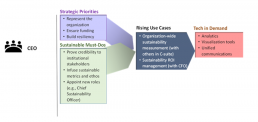Digital technology plays a mixed role in the Anthropocene era. On the one hand, data centers devour enormous amounts of energy. Hardware requires rare-earth elements that are sometimes extracted using destructive practices in poverty-stricken locations and eventually discarded into landfills. Efficiency gains enabled by IT have led to greater exploitation of limited natural resources ranging from oil and gas to fish and arable land.
On the other hand, digital technology has been instrumental in powering sustainability. Forward-looking C-suite leaders have launched strategies that leverage digital technology to achieve sustainability objectives.
This new era, however, requires a systemic approach to enterprise good works. Goals such as reducing carbon footprints, facilitating circular economies, ensuring positive social impacts, and inclusion must be woven into operations, product and service design and development, and corporate processes and culture.
In so doing, C-suites also recognize the need to demonstrate ROI for sustainability efforts. Sustainable projects need to self-sustain from a business standpoint, especially amid the current economic crisis.
In many areas, this should be straightforward. C-suites should use strong KPIs (not just monetary measures) to analyse the direct and indirect impact of sustainability projects on the enterprise’s top and bottom lines. Improved efficiency can be linked to reduced resource utilization and lower carbon footprints.
Increased inclusion increases product and service innovation (though this can tricky). Sustainable and fair-trade sourcing improves trust, reputation and long-term loyalty.
Enterprises aiming to make sustainability systemic have found success in three main areas:
Using Organizational Structure to Support Sustainability
Getting returns on sustainability projects is intimately related to having organizational structures and processes in place that enable such projects to succeed. It starts at the top: CEOs must lead by example and set the company’s vision.
The board needs to include a chief sustainability officer endowed with a team that has authority and visibility across the organization. The sustainability message and objectives need to be embedded in business functions.
The goal is the creation of a matrix in which local sustainability representatives can guide local functions toward the achievement of sustainability goals, regulatory obligations, best practices, and KPIs.
Adopting a Use Case Approach to Technology Development
Though digital technology is critical to sustainability, use cases must come first — or rather, strategic imperatives must be translated into sustainability must-dos at the C and C-1 levels. Must-dos can be broken down into clear use cases, facilitated by core technology.
A broad HR goal, for example, is employee satisfaction. Because employee contributions to sustainability goals have been shown to improve employee satisfaction, this gives organizations an opportunity to create new use cases.
They can, for example, gamify individual power consumption to enable employees to compete with other over who can save the most energy while working. Gamification may depend on a mix of social media, real-time analytics, and AI to be effective.
Allowing C-Suites to Be Transformed by Sustainable Goals
The dawn of the sustainable era does not change traditional corporate goals. It does, however, enrich them — and, in some cases, compel the reprioritization of agendas. This is where sustainability must-dos can have an impact.
The drive for environmental and social influence, for example, will guide how CEOs promote their companies’ visions. A human capital leader will boost efforts to ensure that talent is both plentiful and diverse.
The COO of a manufacturing company will increasingly balance the imperative of efficiency with the need to make the supply network transparent from an ethical and environmental sourcing standpoint.

The figure above shows examples of how Sustainability impacts certain roles within the organization. If you want to know more about how other roles are affected and how technology is being used to drive sustainable use cases and applications, take a look at the IDC EMEA new Subscription Service: Technology for Sustainability and Social Impact or contact Marta Muñoz or head over to https://www.idc.com/eu.


